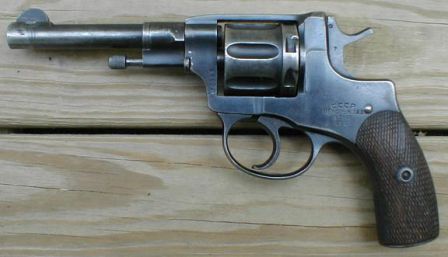Russian-made Nagant revolver (circa 1925)
Cut-out view of the M1895 Nagant revolver
Type: Double Action
Chamber: 7.62mm Nagant
Weight unloaded: 750 g
Length: 230 mm
Barrel length: 114 mm
Capacity: 7 rounds
Chamber: 7.62mm Nagant
Weight unloaded: 750 g
Length: 230 mm
Barrel length: 114 mm
Capacity: 7 rounds
This revolver was designed in Belgium by Nagant brothers (Emile and Leon) in the late 1880s - early 1890s, and was adopted by numerous countries, including Sweden and Poland, but the major user and manufacturer was undoubtfully Russia (and later Soviet Union). Russian government adopted Nagant revolver in 1895, and local production began in 1898 (first shipments were from Belgium). It was a standard russian sidearm until 1930, when M1895 Nagant was declared obsolete, but it was widely used and manufactured during World War 2, and manufacture was finally ceased circa 1950.
Later, some sporting revolvers, both in 7.62mm and in .22LR were developed on Nagant platform. Intertestingly enough, the M1895 revolvers still can be seen carried by some security personnel in Russia, especially by Railroad Security and by some armed guards. Usually, those revolvers are 2 to 4 times older than men who carry these guns.
From technical point of view, Nagant revolvers were already almost outdated at the moment of its adoption in 1895, since newest revolvers like S&W Hand Ejectors or Colts with side-opened cylinders were much faster to reload. On the other hand, M1895 had some unusual and interesting features, one of which was gas sealed cylinder, which made the Nagant a rare example of revolver suitable for mounting a silencer. Such a practice was known by NKVD and some Red Army special forces (recon and scouts) during WW2. Special silencer, called "Bramit device" was designed by Mitin brothers and could be mounted on the barrel.
M1895 Nagand was a solid frame, seven shot revolver with non-removable cylinder. The loading and unloading was committed wia the loading gate at the right side of the frame, one cartridge by one. Spent cases were ejected by the ejector rod, which, when not in use, was concealed within the cylinder axis and swung to the side on the ejector rod link to be used. Original guns were double action ones, but Tsarists government ordered that some of M1895 should be retrofitted with Single Action triggers and issued to enlisted men, and DA guns should be issued only to the Officers and Police. In Red (Soviet) army only Double Action Nagants were issued.
The gas sealed cylinder, mentioned above, was made to use all of powder gases to propel the bullet (in most revolvers some gases escape from the gap between the cylinder face and barrel breech). To achieve that, the cylinder moves ahead a bit when hammer is cocked, enclosing a barrel breech area with recess in the front of each chamber. The cartridge, unique to that design, had long case with tapered mouth and a bullet totally enclosed inside the case. When cylinder moves forward, the cartridge case mouth entered the barrel breech and was used as additional seal. This was a complicated mechanism, useful mostly when guns were used with silencer.
Being somewhat complicated and relatively slow to reload, with ammunition of marginal power, Nagants were otherwise good guns, reliable, acurate and quite popular among the troops.


 08.14
08.14
 Jack The Ripper
Jack The Ripper



 Posted in:
Posted in:
0 komentar:
Posting Komentar